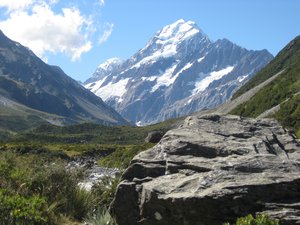Advertisement
Published: March 17th 2010

 1
1
Mt. CookAoraki is the Maori name for Mt. Cook. Mt. Cook is the tallest mountain in New Zealand, at 12,316 feet, and one of the places where Sir Edmund Hillary (then just "Ed") began his illustrious mountaineering career. Mt. Cook is snow-capped year round and is flanked by two large glaciers (named Tasman and Hooker).
Mt. Cook is part of the Southern Alps, a long mountain range on the South Island that generally runs north-south. Local Maori tribes see Mt Cook as the physical manifestation of the most sacred of ancestors which provides the iwi (tribe) with its sense of communal identity, solidarity and purpose. As such, Aoraki is the link between the supernatural and the natural world.
It is said (in New Zealand) that you never forget the first time you see Mt. Cook. For us, that was three years ago when we were exploring the Fox and Franz Joseph glaciers on the West Coast. Mt. Cook was more or less hiding in the clouds that day, but then the clouds parted and, for about 15 seconds, we saw the breathtaking snow-capped peak. The clouds moved in before we could take a photograph but we were impressed just the

 2
2
Another shot of Mt. Cooksame.
To increase our chances of seeing (and photographing) Mt. Cook on our current trip, we decided to spend a night near Mt. Cook during our roadtrip from Christchurch to Queenstown. If you ever find yourself making the trip from Christchurch to Queenstown, you must stay at this place: Omahau Downs, a B&B on a working sheep farm near the tiny township of Twizel, about 55km from Mt. Cook Village. The B&B's four rooms all face Mt. Cook and, on a clear day, have magnificient views. The owners, Sean and Nicky, are some of the most lovely and hospitable people we've met in the past six months.
We got extremely lucky. The weather gods blessed us with superb weather - the clearest blue skies - not only when we arrived on the 5th but also when we drove back through the area (we enjoyed the B&B and the area so much that we stopped here again in late February).
The views on the drive to Mt. Cook Village, across glacial Lake Pukaki, are almost as breathtaking as the mountain itself. Once you reach Mt. Cook Village, there's plenty to do. On our first visit, we did a

 3
3
Angelique on the path to Hooker Lake.great day hike out to Kea Point with Angelique's mom. On our second visit we tried to go kayaking on Lake Mueller (the glaciers occasionally drop large 500-year-old icebergs into this lake, making for an unearthly experience paddling through them) but unfortunately the winds were gusting up to 40 mph so the kayak trip was cancelled. Instead we hiked up the Hooker Valley to another lake filled with icebergs. The howling winds made the hike interesting but we are glad we perservered.
Mt. Cook National Park is an excellent area for tramping (trekking) with many multi-day options (staying overnight in huts). There are also plenty of mountaineering options for those with crampons, ice axes and a lot of courage (and experience; over 200 people have died on climbing-related accidents on Mt. Cook). Finally, the Mt. Cook area must be one of the best places in the Southern Hemisphere to see the stars. We spent one evening, after a sublime sunset, gazing at the Milky Way and the Southern Cross, a prominent cluster of stars in the Southern sky which the Maroi used as a navigational aid during their early ocean crossings to/from Polynesia and New Zealand. Amazing!
Advertisement
Tot: 0.073s; Tpl: 0.01s; cc: 11; qc: 29; dbt: 0.048s; 1; m:domysql w:travelblog (10.17.0.13); sld: 1;
; mem: 1mb

 1
1
 2
2
 3
3